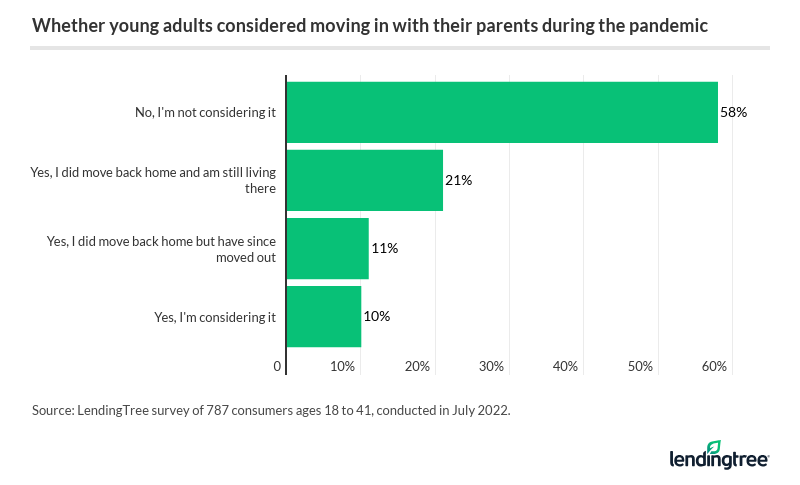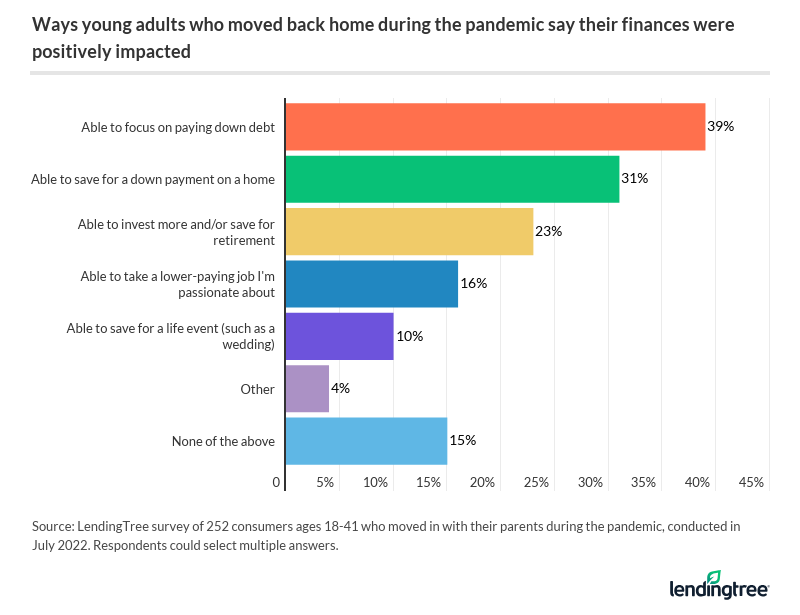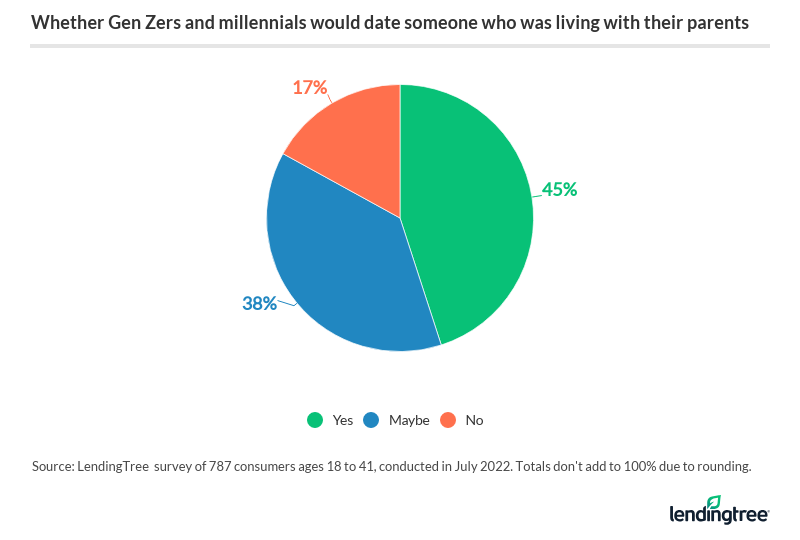Two-Thirds of Millennials and Gen Zers Who Moved Back Home During the Pandemic Still Live There
The pandemic turned back time for many empty nesters, as their homes were suddenly filled with the pitter-patter of their young adult children’s feet returning to the relative safety and financial security of their parents’ homes. But in the two-plus years since the pandemic’s onset, only a third of those who returned home during the pandemic have spread their wings and flown their parents’ coop again.
LendingTree surveyed more than 1,300 U.S. parents and/or Generation Zers or millennials to get their thoughts on post-pandemic parent-living arrangements. LendingTree researchers also analyzed U.S. Census Bureau data to create a national and state-by-state snapshot of the number of younger adults living at home.
Key findings
- Nearly a third (32%) of millennials and Gen Zers moved back home with their parents during the pandemic, and most still live there. Two-thirds of young adults who moved back home remain with their parents. Slightly more than half (51%) of those who moved home say it was out of necessity.
- Young adults who moved in with their parents during the pandemic are focusing on paying down debt and saving for a home. Of those who moved back home, 39% say they’ve been able to pay down debt, while 31% are focusing on saving for a down payment. And of those who’ve since moved out, nearly 3 in 10 purchased a home. But whether they bought or rented, 71% would only return home if they had no other option.
- Living at home isn’t a dating deal breaker. 45% of millennials and Gen Zers say they’d date someone living with their parents, and an additional 38% would consider it. Only 17% flat-out refuse.
- 85% of parents would let their children move back in as adults or have previously done so, and most (73%) wouldn’t charge them rent. However, more than half say their kids would need to get a job, help pay for groceries and other household bills and assist with chores like cooking and cleaning.
- The percentage of adults ages 24 to 40 who live with their parents is above 20% in three states: Hawaii (21.6%), New Jersey (20.7%) and Florida (20.1%). Meanwhile, in North Dakota, just 5.3% of these adults live with their parents.
32% of young adults moved back home during the pandemic — two-thirds of which are still there
Nearly 3 in 10 Gen Zers (ages 18 to 25) are camping out with their folks to save a buck during the pandemic, followed by 18% of younger millennials (ages 26 to 34) and 17% of older millennials (ages 35 to 41).
The younger age groups are more likely to have already moved back out. Those ages 26 to 34 lead the flight away from the nest (14%), followed by 13% of 18- to 25-year-olds. Only 8% of 35- to 41-year-olds who moved to their parents’ homes during the pandemic are back on their own.
Going further, 1 in 10 Gen Zers and millennials are still considering trading freedom to save dollars. The 35- to 41-year-old group is the most adamant about avoiding a move back under their parents’ roof (67%), followed by those ages 26 to 34 (56%) and those 18 to 25 (49%).

Gen Zers and millennials are almost even on whether they moved home out of necessity (51%) or to save money (49%). But for those considering leaving again, inflation may hamper their ability to do so.
“With inflation as high as it is and with rates rising, it can be difficult for anyone to make ends meet in today’s economy,” says Jacob Channel, LendingTree senior economist.
Younger people still working in entry-level positions may not have the cash resources to overcome the financial stressors of inflation, according to Channel.
While back home, Gen Zers and millennials focus on paying down debt, saving for a down payment
Most young adults who moved back with their parents during the pandemic focused on clearing debt (39%) — saving up for a home down payment, however, was a close second (31%). But no matter the generation, a 2021 LendingTree study shows that credit card debt is the most common nonmortgage debt burden that people carry. Channel also suggests focusing on reducing your student loan or auto loan debt before heading back out on your own.

About 1 in 4 young adults opted to invest more or save for retirement (23%). Pursuing a lower-wage job more aligned with their passions appealed to 16% of young adults, while being home stirred up baby or wedding fever for 10%.
Once Gen Zers and millennials flew the coop again, they were more likely to rent (73%) than buy a home (27%). However, that doesn’t mean they should avoid homebuying altogether.
Still, desperate times may call for desperate homebound measures in the future — in fact, 70% of young adults would head back home again only if they had no other option.
Is living at home a dating deal breaker?
Living in your parents’ basement may be the new normal in the dating world, with 83% of young adults giving a “yes” (45%) or “maybe” (38%) to the question of dating someone still situated in parental living quarters.

However, older Americans are more likely to shoot down a proposition if you’re still at home. Here’s the breakdown by age group by definite thumbs-downs to dating you if you’re still in your parents’ home:
- 18 to 25 (12%)
- 26 to 34 (17%)
- 35 to 41 (22%)
Only 36% of women are willing to consider dating someone living at home, compared with 54% of men who would be OK dating an individual living with their parents. However, women on the “maybe” scale (44%) outnumber the “maybe” men (32%).
Most parents are OK with their adult kids moving back home
Most parents would allow their adult kids to live at home (56%) if needed, while 29% already have or are currently living with grown-up children. Older parents are less likely to embrace the idea of their adult offspring staying at home — perhaps because they’ve already experienced the rigors of raising a child to adulthood versus younger Americans who are still starry-eyed “baby dreamers.”
Of those who would definitely let their adult kids live at home again:
- 80% are ages 26 to 34
- 70% are 35 to 41
- 57% are 42 to 56
- 31% are 57 to 76
Despite apparent resistance to the idea of letting their grown-up kids live back home with them, the needs of adult children at home are already being met by the oldest parents. The following age groups currently or previously have allowed Gen Z or millennial kids to live at home again:
- 57 to 76 (45%)
- 42 to 56 (32%)
- 35 to 41 (17%)
- 26 to 34 (11%)
Only 1 in 10 parents wouldn’t set any rules for adult children living at home. Most parents would add financial strings to an adult-at-home occupancy, including:
- 58% that expect their kids to help with cleaning and cooking
- 56% that would want cash to pay for groceries and other household expenses
- 53% that would expect their at-home adult kid to be gainfully employed
- 27% that would expect rent payment
- 11% would need a set move-out date
- 10% would set a curfew

About half (49%) of parents who’ve let their adult children move back in say it improved their relationship. On the other hand, 21% say living with their adult child strained their relationship.
Adults living with parents most common in Hawaii, New Jersey and Florida
Adult children are most likely to reside at home in Hawaii (21.6%), New Jersey (20.7%) and Florida (20.1%). The cost of living is a likely reason for many stay-at-home adult children living in Hawaii and New Jersey, considering how expensive day-to-day expenses are in both states.
Adult children living at home in Florida, a state where the cost of living is lower, may be at home to care for an older parent. As of 2019, Florida had the second-highest population of residents 65 or older, with more than 1 in 5 (20.9%) in that age demographic statewide.
North Dakota (5.3%), Nebraska (8.0%) and South Dakota (8.3%) had the lowest percentage of adult children living with parents. The low unemployment rates in these states may be part of the reason. As of July 2022, Nebraska’s unemployment rate is 2.0%, while both Dakotas come in at 2.3%. That’s significantly less than the unemployment rate of the top-ranking stay-at-home kid states of Hawaii (4.1%) and New Jersey (3.7%).
| Rank | State | Number of adults ages 24 to 40 | Number who live with their parents | Percentage who live with their parents |
|---|---|---|---|---|
| U.S. | 67,801,901 | 10,867,870 | 16.0% | |
| 1 | Hawaii | 296,852 | 64,061 | 21.6% |
| 2 | New Jersey | 1,771,276 | 367,465 | 20.7% |
| 3 | Florida | 4,086,452 | 819,393 | 20.1% |
| 4 | California | 8,636,862 | 1,697,221 | 19.7% |
| 5 | Rhode Island | 212,653 | 41,522 | 19.5% |
| 6 | New York | 4,204,350 | 800,084 | 19.0% |
| 7 | Maryland | 1,226,619 | 231,068 | 18.8% |
| 7 | New Mexico | 415,182 | 78,123 | 18.8% |
| 9 | Delaware | 184,628 | 34,380 | 18.6% |
| 10 | Mississippi | 597,031 | 109,313 | 18.3% |
| 11 | Connecticut | 667,075 | 119,068 | 17.8% |
| 11 | Louisiana | 1,008,255 | 179,268 | 17.8% |
| 13 | Alabama | 971,433 | 172,131 | 17.7% |
| 13 | South Carolina | 1,014,540 | 179,390 | 17.7% |
| 15 | Georgia | 2,205,921 | 374,240 | 17.0% |
| 16 | Massachusetts | 1,417,725 | 238,487 | 16.8% |
| 17 | West Virginia | 334,371 | 55,240 | 16.5% |
| 18 | Pennsylvania | 2,534,036 | 416,176 | 16.4% |
| 19 | Arizona | 1,457,967 | 232,743 | 16.0% |
| 20 | Illinois | 2,657,959 | 422,411 | 15.9% |
| 20 | Texas | 6,321,638 | 1,006,805 | 15.9% |
| 22 | New Hampshire | 255,403 | 39,397 | 15.4% |
| 23 | Virginia | 1,761,450 | 268,099 | 15.2% |
| 24 | Alaska | 171,092 | 25,645 | 15.0% |
| 25 | Michigan | 1,926,368 | 287,024 | 14.9% |
| 25 | Nevada | 660,697 | 98,162 | 14.9% |
| 25 | North Carolina | 2,077,274 | 308,539 | 14.9% |
| 28 | Tennessee | 1,409,641 | 205,236 | 14.6% |
| 29 | Kentucky | 890,496 | 119,757 | 13.4% |
| 30 | Ohio | 2,312,619 | 307,225 | 13.3% |
| 31 | Arkansas | 608,128 | 78,691 | 12.9% |
| 32 | Indiana | 1,346,644 | 171,239 | 12.7% |
| 33 | Missouri | 1,237,354 | 155,829 | 12.6% |
| 34 | Oklahoma | 823,719 | 102,621 | 12.5% |
| 35 | Maine | 243,415 | 29,573 | 12.1% |
| 35 | Utah | 683,399 | 82,705 | 12.1% |
| 37 | Colorado | 1,321,304 | 153,052 | 11.6% |
| 37 | Oregon | 892,626 | 103,528 | 11.6% |
| 39 | District of Columbia | 218,971 | 24,317 | 11.1% |
| 39 | Vermont | 116,674 | 12,994 | 11.1% |
| 41 | Idaho | 351,020 | 38,191 | 10.9% |
| 42 | Washington | 1,704,512 | 184,634 | 10.8% |
| 43 | Wisconsin | 1,137,041 | 119,636 | 10.5% |
| 44 | Minnesota | 1,157,892 | 119,708 | 10.3% |
| 45 | Montana | 206,927 | 20,110 | 9.7% |
| 46 | Kansas | 578,155 | 55,454 | 9.6% |
| 47 | Wyoming | 116,715 | 10,998 | 9.4% |
| 48 | Iowa | 624,033 | 51,436 | 8.2% |
| 48 | South Dakota | 180,127 | 14,859 | 8.2% |
| 50 | Nebraska | 393,368 | 31,543 | 8.0% |
| 51 | North Dakota | 172,012 | 9,079 | 5.3% |
Source: LendingTree analysis of microdata from the U.S. Census Bureau 2020 American Community Survey (with five-year estimates). Adults who live with their parents are defined as people between the ages of 24 and 40 who haven’t attended school within the past three months and are identified as the natural, adopted or stepchild of the householder.
Methodology
LendingTree commissioned Qualtrics to conduct an online survey of 1,324 U.S. consumers from July 26-29, 2022. All respondents were either parents and/or Generation Zers (ages 18 to 25) or millennials (ages 26 to 41). The survey was administered using a nonprobability-based sample, and quotas were used to ensure the sample base represented the overall population. All responses were reviewed by researchers for quality control.
LendingTree researchers also analyzed microdata from the U.S. Census Bureau’s 2020 American Community Survey (with five-year estimates) to determine the rate of adults ages 24 to 40 who live with their parents and haven’t attended school in the past three months. They had to be identified as the natural, adopted or stepchild of the householder.
